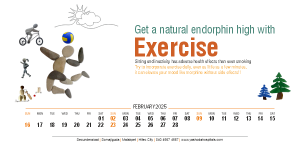Get a Natural Endorphin High with Exercise
Did you know that sitting and inactivity can have more adverse health effects than smoking? It’s true! But here’s the good news: incorporating even a few minutes of exercise into your daily routine can work wonders for your health and mood. Exercise triggers the release of endorphins, the body’s natural feel-good chemicals, offering a euphoric “high” similar to morphine—without any side effects!
So, why wait? A quick walk, a short yoga session, or a set of stretches can be your daily dose of happiness and vitality. Start small, stay consistent, and feel the difference!
The Importance of Physical Activity for Health and Well-being
Exercise is more than just about looking fit—it’s essential for feeling good inside and out. Regular physical activity plays a crucial role in promoting overall health and well-being, while inactivity is closely tied to an increased risk of noncommunicable diseases (NCDs) and other serious health issues. Exercise differs based on the intensities and it measures the effort your heart puts in to pump blood throughout your body.
- Moderate-Intensity Activities: These activities are manageable but increase your heart rate. Examples include brisk walking, dancing, or cycling at speeds slower than 10 mph. They are effective for maintaining overall fitness.
- Vigorous-Intensity Activities: These exercises push your body harder, leading to greater benefits in less time. Examples include running, swimming laps, and jumping rope. They require more effort and stamina compared to moderate-intensity activities.
Types of Exercise and Their Benefits
- Aerobic Exercise (Cardio)
Aerobic exercise involves increasing your heart rate and engaging your heart and lungs. Activities such as running, swimming, cycling, and brisk walking fall under this category. Aerobic exercises help to:- Burn fat and improve mood
- Reduce inflammation and lower blood sugar levels
- Enhance heart and lung function
- Strength Training (Resistance Training)
Strength training exercises, including squats, lunges, push-ups, and weight lifting, are crucial for maintaining and building muscle mass. Aim to perform strength exercises two to three times a week. Benefits include:- Stronger bones and reduced risk of falls
- Lower blood sugar levels and improved balance
- Optimization of lean muscle-to-fat ratio
How Much Exercise Do You Need?
To maintain good health, follow these general guidelines:
- Aerobic Activity: At least 150 minutes of moderate-intensity exercise or 75 minutes of vigorous exercise weekly.
- Strength Training: Work all major muscle groups two to three times a week.
While aerobic exercises are fantastic for burning calories and reducing fat, don’t overlook strength training, which boosts muscle mass, supports bone health, and enhances your metabolic rate.
Understanding VO2 and MET: How Physical Activity Enhances Your Fitness
VO2 (volume of oxygen consumption) and MET (metabolic equivalent of task) are crucial metrics for assessing cardiovascular fitness and energy expenditure.
VO2 (Volume of Oxygen Consumption):
- Measures the amount of oxygen your body uses during exercise.
- A higher VO2 means better endurance and cardiovascular fitness.
- Regular aerobic exercises like running, cycling, and swimming increase VO2 max, enhancing stamina.
MET (Metabolic Equivalent of Task):
- Measures energy expenditure compared to resting.
- One MET is the energy spent while at rest. Higher MET values indicate more intense activities.
- Example: Brisk walking = 4 METs, Jumping rope = 12 METs.
- Helps quantify exercise intensity and allows comparison of different activities.
As you engage in regular physical activity, both VO2 and MET improve, boosting cardiovascular health, enhancing endurance, and increasing the body’s ability to burn calories efficiently. This not only helps improve athletic performance but also promotes overall well-being.
So, next time you lace up your shoes, remember that you’re not just boosting your fitness but optimizing your body’s ability to perform at its best.
Benefits of Regular Physical Activity for All Ages and Stages of Life
The benefits of regular physical activity are undeniable, regardless of your age, gender, or fitness level. Whether you’re already active or just beginning to move more, incorporating exercise into your life can transform your health and well-being.
Here’s how staying active benefits everyone:
For Children and Adolescents
- Improved physical fitness and cardiometabolic health
- Enhanced bone health and cognitive function
- Better mental health and reduced body fat
For Adults and Older Adults
- Lower risk of all-cause and cardiovascular disease mortality
- Reduced risk of hypertension, type 2 diabetes, and site-specific cancers
- Improved mental health, sleep quality, cognitive function, and body fat regulation
- Decreased likelihood of falls
For Pregnant and Postpartum Women
- Reduced risk of pre-eclampsia, gestational hypertension, and gestational diabetes
- Lower chances of excessive gestational weight gain and delivery complications
- Protection against postpartum depression and newborn complications
The Science Behind the “Exercise High”
When you exercise, your body releases chemicals called endorphins that interact with brain receptors, reducing your perception of pain. These endorphins create a euphoric sensation often described as a “runner’s high.” This feeling is accompanied by an energizing and positive outlook on life—a natural, mood-boosting benefit of physical activity!
So, lace up your shoes and get moving! Whether it’s a brisk walk, a strength workout, or a quick yoga session, every bit of activity brings you closer to a healthier, happier you.
For optimal results
The greatest reduction in mortality from vigorous physical activity (VPA) was observed at approximately 150 to 300 minutes per week—double the currently recommended range of 75 to 150 minutes per week. While engaging in higher levels of VPA posed no additional risk to mortality, the benefits plateaued beyond 300 minutes per week, with no further reduction in mortality.
Conclusion
Exercise is a powerful tool for improving both physical and mental health. By incorporating regular physical activity into your routine, whether it’s through aerobic exercises or strength training, you can experience a natural boost in mood, energy, and overall well-being. The benefits of staying active extend across all stages of life, from childhood to pregnancy and beyond. So, don’t wait any longer—start small, stay consistent, and enjoy the positive impact exercise can have on your health. A little effort today can lead to a happier, healthier tomorrow!


 Appointment
Appointment WhatsApp
WhatsApp Call
Call More
More

